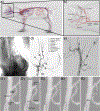Soft robotic steerable microcatheter for the endovascular treatment of cerebral disorders
- PMID: 34408094
- PMCID: PMC9809155
- DOI: 10.1126/scirobotics.abf0601
Soft robotic steerable microcatheter for the endovascular treatment of cerebral disorders
Abstract
Catheters used for endovascular navigation in interventional procedures lack dexterity at the distal tip. Neurointerventionists, in particular, encounter challenges in up to 25% of aneurysm cases largely due to the inability to steer and navigate the tip of the microcatheters through tortuous vasculature to access aneurysms. We overcome this problem with submillimeter diameter, hydraulically actuated hyperelastic polymer devices at the distal tip of microcatheters to enable active steerability. Controlled by hand, the devices offer complete 3D orientation of the tip. Using saline as a working fluid, we demonstrate guidewire-free navigation, access, and coil deployment in vivo, offering safety, ease of use, and design flexibility absent in other approaches to endovascular intervention. We demonstrate the ability of our device to navigate through vessels and to deliver embolization coils to the cerebral vessels in a live porcine model. This indicates the potential for microhydraulic soft robotics to solve difficult access and treatment problems in endovascular intervention.
Copyright © 2021 The Authors, some rights reserved; exclusive licensee American Association for the Advancement of Science. No claim to original U.S. Government Works.
Conflict of interest statement
Competing interests:
TG and JF are authors on a patent application US20190209811A1, “Hydraulically driven surgical apparatus,” submitted by the University of California and which covers design and manufacturing methods for the steerable catheter and control system [28]. AK received options for serving as a medical board advisor to Ospitek as a consultant on inventory and patient tracking in outpatient surgery centers, which does not overlap with the research reported in this paper. AK is on the steering committee for the EMBOLISE trial for Medtronic; this trial is examining middle meningeal artery embolization for treating subdural hematoma; Medtronic is not involved in the research reported in this study and the EMBOLISE trial has no relevance to steerable catheter technology, though Medtronic does have an endovascular device portfolio. AK serves on the global advisory board of Cerenovus, the endovascular arm of Johnson and Johnson, receiving modest consulting income from the arrangement. Cerenovus, Johnson and Johnson are not involved in this paper’s work nor is AK’s relationship connected in any way to this activity.
Figures








Similar articles
-
Tailor-made shaping of microcatheters using three-dimensional printed vessel models for endovascular coil embolization.Comput Biol Med. 2016 Oct 1;77:59-63. doi: 10.1016/j.compbiomed.2016.07.005. Epub 2016 Aug 2. Comput Biol Med. 2016. PMID: 27521515
-
Ascent™: a novel balloon microcatheter device used as the primary coiling microcatheter of a basilar tip aneurysm.J Neuroimaging. 2012 Apr;22(2):191-3. doi: 10.1111/j.1552-6569.2011.00619.x. Epub 2011 Jun 24. J Neuroimaging. 2012. PMID: 21707825
-
Three-dimensional spiral-shaping method of microcatheter for paraclinoid aneurysms: assessment using silicone models.Nagoya J Med Sci. 2024 Nov;86(4):655-664. doi: 10.18999/nagjms.86.4.655. Nagoya J Med Sci. 2024. PMID: 39780921 Free PMC article.
-
Brain aneurysms and arteriovenous malformations: advancements and emerging treatments in endovascular embolization.Stroke. 2007 Apr;38(4):1411-7. doi: 10.1161/01.STR.0000259824.10732.bb. Epub 2007 Feb 22. Stroke. 2007. PMID: 17322071 Review.
-
Advances in endovascular aneurysm management: coiling and adjunctive devices.Stroke Vasc Neurol. 2020 Mar 15;5(1):14-21. doi: 10.1136/svn-2019-000303. eCollection 2020. Stroke Vasc Neurol. 2020. PMID: 32411403 Free PMC article. Review.
Cited by
-
New concept in neurovascular navigation: technical description and preclinical experience with the Bendit 17 and Bendit 21 microcatheters in a rabbit aneurysm model.J Neurointerv Surg. 2023 Feb;15(2):172-175. doi: 10.1136/neurintsurg-2022-018644. Epub 2022 Mar 15. J Neurointerv Surg. 2023. PMID: 35292566 Free PMC article.
-
Design Optimization of a Hybrid-Driven Soft Surgical Robot with Biomimetic Constraints.Biomimetics (Basel). 2024 Jan 21;9(1):0. doi: 10.3390/biomimetics9010059. Biomimetics (Basel). 2024. PMID: 38275456 Free PMC article.
-
Self-folding soft-robotic chains with reconfigurable shapes and functionalities.Nat Commun. 2023 Mar 7;14(1):1263. doi: 10.1038/s41467-023-36819-z. Nat Commun. 2023. PMID: 36882398 Free PMC article.
-
Robotics and Artificial Intelligence in Endovascular Neurosurgery.Cureus. 2022 Mar 30;14(3):e23662. doi: 10.7759/cureus.23662. eCollection 2022 Mar. Cureus. 2022. PMID: 35371874 Free PMC article. Review.
-
Materials Advances in Devices for Heart Disease Interventions.Adv Mater. 2025 Jul;37(27):e2420114. doi: 10.1002/adma.202420114. Epub 2025 Apr 17. Adv Mater. 2025. PMID: 40244561 Free PMC article. Review.
References
-
- Ali A, Sakes A, Arkenbout EA, Henselmans P, van Starkenburg R, Szili-Torok T, and Breedveld P. Catheter steering in interventional cardiology: Mechanical analysis and novel solution. Proceedings of the Institution of Mechanical Engineers, Part H: Journal of Engineering in Medicine, 233(12):1207–1218, 2019. - PMC - PubMed
-
- Arya A, Hindricks G, Sommer P, Huo Y, Bollmann A, Gaspar T, Bode K, Husser D, Kottkamp H, and Piorkowski C. Long-term results and the predictors of outcome of catheter ablation of atrial fibrillation using steerable sheath catheter navigation after single procedure in 674 patients. Europace, 12(2):173–180, 2009. - PubMed
-
- Atmakuri SR, Lev EI, Alviar C, Ibarra E, Raizner AE, Solomon SL, and Kleiman NS. Initial experience with a magnetic navigation system for percutaneous coronary intervention in complex coronary artery lesions. Journal of the American College of Cardiology, 47(3):515–521, 2006. - PubMed
-
- Avitall B. Catheter deflection control, Aug. 15 1995. US Patent 5,441,483.
-
- Bergeles C and Yang G-Z. From passive tool holders to microsurgeons: safer, smaller, smarter surgical robots. Biomedical Engineering, IEEE Transactions on, 61(5):1565–1576, 2014. - PubMed

